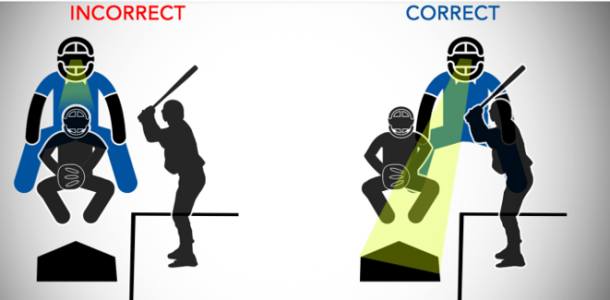Positioning is key for both the plate and base umpires. Correct positioning ensures that the umpire is in the best possible spot to make their call.
PLATE UMPIRE
The home plate umpire is responsible for establishing an athletic position for the purpose of ruling on pitches delivered by the pitcher, while also working in close proximity to the catcher and batter. Review the following videos for a thorough explanation of “The Slot” and other related plate mechanics. To achieve effective positioning that will result in a consistent strike zone for the duration of the game, the slot is used. The slot is defined as the space between the chest of the batter and the catcher’s shoulder closest to the batter. Without turning the head, the umpire is to use his eyes to track each pitch from the pitcher’s release point until the ball is received into the glove of the catcher. “Being in the slot,” affords the umpire an unimpeded view of the pitch, whether the pitch passes over home plate through the inner, middle, or outer part of the strike zone, or fails to pass through the strike zone.

An umpire should never place his hand on the back of a catcher or initiate any form of contact. To be “aggressive in the slot” describes a slight adjustment of feet that will create a better angle for the umpire to see the outside corner of the plate.
BASE UMPIRE - FOR MAJOR DIVISION AND BELOW
Regardless of where the base umpire is standing on the field (see positions A, B, & C below), the base umpire should be in set position as the pitcher is about to throw the ball. This position is used regardless if there are runners on base or not. This position may also be used when there is a play at a base and time allows. The foundation to a good “Hands-on-Knees Set” position is a wide stance. Set your feet just wider than shoulder width apart. Your weight is distributed on the balls of the feet to not get caught flat-footed when a play occurs. With the wide stance established, sit straight down and place your hands on your knees. Prior to placing the hands on the knees, form a “V” by keeping the fingers together and separating the thumb. Set the “V” right above the kneecap with the thumb on the inside of the leg and the fingers on the outside. The elbows should be locked and back flat, not rounded. You should be set prior to the pitch being delivered. Just before the pitcher delivers the ball, the head should move from the pitcher to the batter to assist with any play that may occur, such as a check swing.
Video - Hands on knees set position
A Position: The base umpire is in "A" position when there is no runner on base. When the batter is at the plate, the base umpire stands just inside the foul line, approximately 12 feet behind the bag. If the first baseman is playing deep, the umpire backs up so as to not interfere with the player.
Video - Base umpire in A position.
The base umpire will then pivot in to the field of play after the ball is hit. The pivot allows the umpire to see the runner touching first base, while also allowing the umpire to track the same runner going into second base.
Video - The pivot
B Position: The base umpire moves into B position if there is a single runner on base - at first base. B position is between second and first base, in the outfield, approximately 25-35 feet from first base. The umpire should have a clear view of the plate and first base. When a ball is batted fair to the outfield, the base umpire moves from the B position into the infield and pivots to clearly see the play being made in the outfield, runners touching the bases, as well as any subsequent play(s) that may be made on the runner(s) at second or first base.
Video - B position
C Position: The base umpire moves into C position when there is a runner on second or third base, second and third bases, or the bases are loaded. C position is between second and third base, two - three steps behind the shortstop, two - three feet off the shortstop's left shoulder. The umpire should be between 15-30 feet from second base. The intent is for the umpire to be positioned in front of, or ahead of, the lead runner in order to see a play on the lead runner. When a ball is batted fair on the ground, or in the air, to the outfield, the umpire is to move into the infield grass to gain a clear view of the ball, runners, and bases. The base umpire is responsible for all calls on the bases.
Video - C position